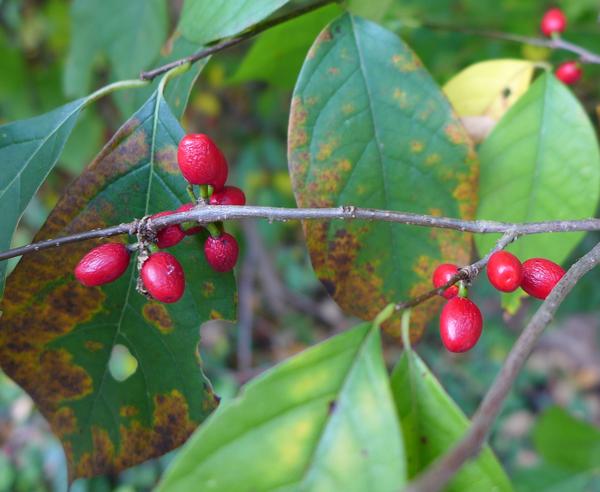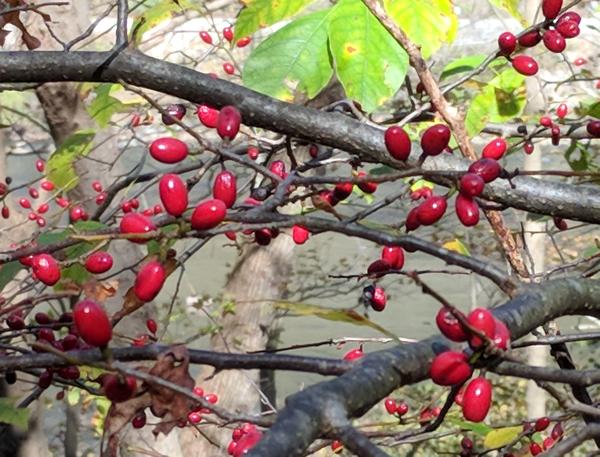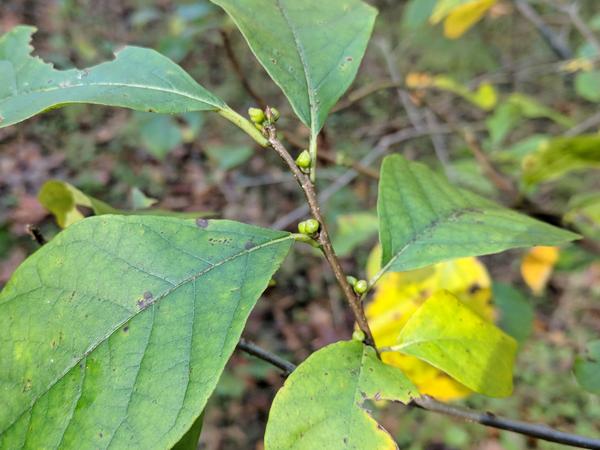
1 November 2017
How do you tell the sex of a spicebush? In autumn the females have bright red fruit.
Flowering plants (angiosperms) have different ways of reproducing:
- 90% of species have “perfect” flowers containing both male and female parts — stamens and pistils. “Perfect” flowers are bisexual or hermaphrodites.
- Monoecious species have separate male and female flowers on the same plant. Did you know that corn (maize) is monoecious? The tassle on top is the male flower; the corncob grows from the female flower.
- Dioecious species have male and female flowers on separate plants. Only 6% of flowering plants are dioecious, mostly woody species.
Spicebush (Lindera benzoin) is dioecious but I didn’t know that when I encountered this explosion of spicebush berries in the Laurel Highlands.

Right next to the fruit-laden bush was another one with no fruit at all — just tiny green knobs, the buds for next spring. Why?
Aha! This plant is male.

If you know what to look for you can sex spicebush at any time of year but autumn is the easiest. In spring the spicebush flowers are so small that you’ll want a magnifying glass to see their tiny structures.
For closeups of male and female spicebush flowers click here at the Awesome Native Plants website.
(photos by Kate St. John)
Reminds me of my days working in a garden center. I’d have to have the “sex talk” with customers about their holly bushes, which are also male and female. Always brought a smile to their faces.
Will the female spicebush have berries even if a male spicebush is not around? We have one and would like to know how to tell its sex so we can get a mate for it. 🙂
To determine the sex of your own spicebush, look at the flowers in the spring. This Penn State website says that female flowers (click to see photo) are small and yellow with six colored sepals and no petals. Male flowers have nine, reddish stamens. (click for a photo of male flowers)
My guess is that the best time to buy one is either in fall, when you can see if it has fruit, or in spring when it’s blooming.
I have a single Spicebush and this year I noticed red berries on it for the first time. So yes, the female does have berries even if there’s no male present.
What distance is optimal between male and female plants to produce berries? For example to pollinate my viburnum there must be another within 50 ft. Thank you in advance.
Karen, I don’t know the answer but here is some advice that talks about it. “Close enough for pollination” requires knowing who pollinates it. Scroll to bottom: http://www.louistheplantgeek.com/a-gardening-journal/974-today-in-the-garden-of-a-lifetime-spice-bush-in-flower-but-with-smaller-flowers
In optimal growing conditions, at what age does a Spicebush (Lindera benzoin) produce flowers and/or fruit to determine sex?
Does a 2 year old plant exhibit these sex characteristics?
The Holden Arboretum has this to say about spicebush (at this link https://holdenarb.org/horticulture/plant-profiles/lindera-benzoin-spicebush/) :
Growth rate of our [spicebush] plants has been a foot or more per year when young. … Also, for such plants fruiting has begun during the first three to six years.
Are there names of the male/female plants, ala red sprite/jim dandy for winterberry, so that we know what we’re getting? And able to make the match? Nurseries that I’ve searched online don’t seem to provide this info.
Barbara, the names you list are set by growers who breed the plants. The plants I write about are in the wild so they don’t have cultivation names.
Do the swallowtail butterflies care if a Spicebush is male or female?
No, the butterflies do not care what sex the plant is according to this answer at Missouri Wildflowers: https://mowildflowers-net.3dcartstores.com/productqa.asp?action=listallqa&catalogid=163#:~:text=Spicebush%20is%20a%20host%20plant,could%20mimic%20a%20green%20snake.
Would love some visual examples of sexing spice bushes by the buds in the fall. I have two with buds on them currently. Can I send photos for someone to look at?
Rachel Emmett, I don’t know enough about spicebush buds to answer your question but if you email a member of the Botanical Society of Western PA they may be able to help you. Their contact list is here: https://www.botsocwpa.org/contact-us.php